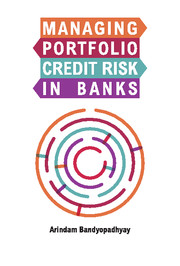Book contents
- Frontmatter
- Dedication
- Contents
- Tables, Figures, Charts
- Preface
- Acknowledgements
- Abbreviations
- 1 Introduction to Credit Risk
- 2 Credit Rating Models
- 3 Approaches for Measuring Probability of Default (PD)
- 4 Exposure at Default (EAD) and Loss Given Default (LGD)
- 5 Validation and Stress Testing of Credit Risk Models
- 6 Portfolio Assessment of Credit Risk: Default Correlation, Asset Correlation and Loss Estimation
- 7 Economic Capital and RAROC
- 8 Basel II IRB Approach of Measuring Credit Risk Regulatory Capital
- Index
2 - Credit Rating Models
Published online by Cambridge University Press: 05 May 2016
- Frontmatter
- Dedication
- Contents
- Tables, Figures, Charts
- Preface
- Acknowledgements
- Abbreviations
- 1 Introduction to Credit Risk
- 2 Credit Rating Models
- 3 Approaches for Measuring Probability of Default (PD)
- 4 Exposure at Default (EAD) and Loss Given Default (LGD)
- 5 Validation and Stress Testing of Credit Risk Models
- 6 Portfolio Assessment of Credit Risk: Default Correlation, Asset Correlation and Loss Estimation
- 7 Economic Capital and RAROC
- 8 Basel II IRB Approach of Measuring Credit Risk Regulatory Capital
- Index
Summary
Credit ratings represent an opinion on the inherent credit quality of a borrower and act as a summary of diverse risk factors to indicate the default probability of the borrower. Risk assessment is the key objective and, hence, the assessment revolves around the measures of risk for creditors. The task for credit scoring is assigning a numeric formula to arrive at a summary number, which aggregates all the risks of default related to a particular borrower. The final score should be a relative indicator of a particular outcome (most often, creditworthiness or default probability of a borrower). However, as of now, credit-scoring models are not only limited to predicting credit worthiness but also used in predicting potential default.
Rating matters to ascertain the financial health of individual obligor, facilities and portfolios and thereby assist in lending decisions. Ratings allow to measure credit risk and to manage consistently a bank's credit portfolio, that is, to alter the bank's exposure with respect to the type of risk. Ratings are useful for pricing of a bond or a loan with respect to the type of risk. As Indian commercial banks start appreciating the need for a structured credit risk management framework, it is imperative for them to incorporate some systematic process that will comprehensively and objectively capture and evaluate the creditworthiness of the corporate/SME/retail clients of a bank in the perspective of changing market dynamics and to store the historic credit rating data for future generation of default and transition probability information.
Whether the credit granted is for working capital requirements or for project finance, it is important to take a long-term view of the industry as well as the business position of a company while rating it and not just the underlying financials of the company. While assessing the financials of the company, the bank's view on the trend in past financial performance, expected future financial performance, ability to raise funds and quality of financial statements submitted need to be taken into consideration. Also, it has been observed that management quality has a significant impact on a company's performance, irrespective of the industry and business characteristics. All these features need to be captured and analyzed in detail.
- Type
- Chapter
- Information
- Managing Portfolio Credit Risk in Banks , pp. 24 - 110Publisher: Cambridge University PressPrint publication year: 2016

